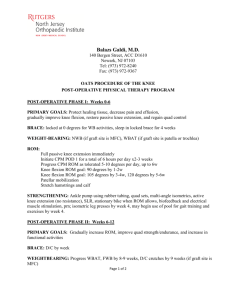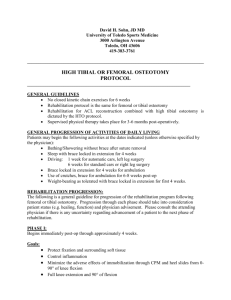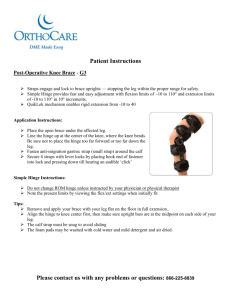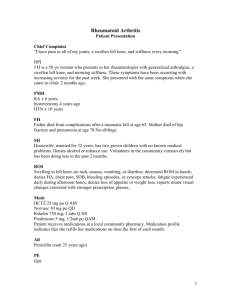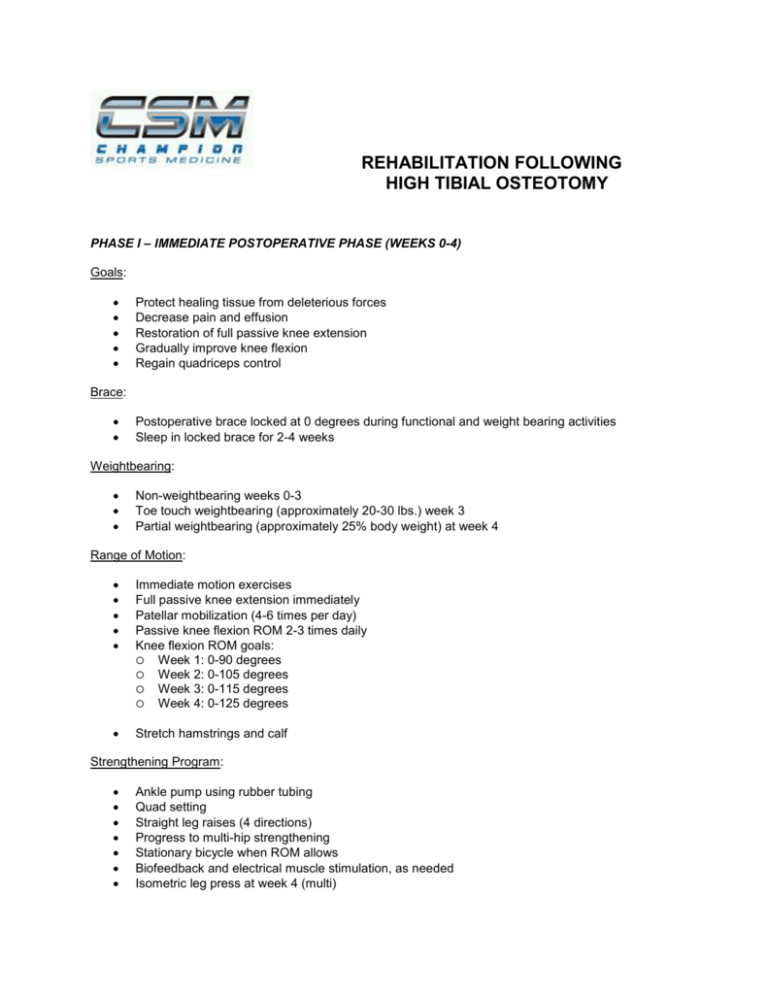
REHABILITATION FOLLOWING
HIGH TIBIAL OSTEOTOMY
PHASE I – IMMEDIATE POSTOPERATIVE PHASE (WEEKS 0-4)
Goals:
Protect healing tissue from deleterious forces
Decrease pain and effusion
Restoration of full passive knee extension
Gradually improve knee flexion
Regain quadriceps control
Brace:
Postoperative brace locked at 0 degrees during functional and weight bearing activities
Sleep in locked brace for 2-4 weeks
Weightbearing:
Non-weightbearing weeks 0-3
Toe touch weightbearing (approximately 20-30 lbs.) week 3
Partial weightbearing (approximately 25% body weight) at week 4
Range of Motion:
Immediate motion exercises
Full passive knee extension immediately
Patellar mobilization (4-6 times per day)
Passive knee flexion ROM 2-3 times daily
Knee flexion ROM goals:
Week 1: 0-90 degrees
Week 2: 0-105 degrees
Week 3: 0-115 degrees
Week 4: 0-125 degrees
Stretch hamstrings and calf
Strengthening Program:
Ankle pump using rubber tubing
Quad setting
Straight leg raises (4 directions)
Progress to multi-hip strengthening
Stationary bicycle when ROM allows
Biofeedback and electrical muscle stimulation, as needed
Isometric leg press at week 4 (multi)
High Tibial Osteotomy – Page 2
May begin use of pool for gait training and exercises week 4
Swelling Control:
Ice, elevation, compression, and edema modalities as needed to decrease swelling
PHASE II – INTERMEDIATE PHASE (WEEKS 4-8)
Goals:
Gradually progress to full weightbearing
Gradually progress to full ROM
Gradually improve quadriceps strength/endurance
Gradual increase in functional activities
Criteria to Progress to Phase II:
Full passive knee extension
Knee flexion to 120 degrees
Minimal pain and swelling
Brace:
Discontinue brace at week 6-8
May progress to joint unloading brace at weeks 6-8
Weightbearing:
Progress weightbearing as tolerated
25% weightbearing weeks 4-5
50% weightbearing week 6
75% weightbearing week 7
Progress to full weightbearing at 8 weeks based on radiographic evaluation
Discontinue crutches at 8 weeks
Range of Motion:
Gradual increase in ROM
Maintain full passive knee extension
Progress knee flexion to 125-135 degrees
Continue patellar mobilization and soft tissue mobilization, as needed
Continue stretching program
Strengthening Exercises:
Initiate weight shifts week 4
Initiate leg press and mini-squats 0-45 degrees week 6
Toe-calf raises week 6
Open kinetic chain knee extension (PRE’s), 1 lb./week
Stationary bicycle (gradually increase time)
Tilt board squats
Continue use of biofeedback and electrical muscle stimulation, as needed
Continue use of pool for gait training and exercise
High Tibial Osteotomy – Page 3
Functional Activities:
As pain and swelling (symptoms) diminish, the patient may gradually increase functional activities
Gradually increase standing and walking tolerance
PHASE III – ADVANCED ACTIVITY PHASE (WEEKS 8-12)
Goals:
Improve muscular strength and endurance
Increase functional activities
Criteria to Progress to Phase III:
Full range of motion
Sufficient strength and proprioception
Minimal pain and swelling
Range of Motion:
Patient should exhibit 125-135 degrees flexion
Exercise Program:
Leg press (0-90 degrees)
Bilateral squats (0-60 degrees)
Unilateral step-ups progressing from 2” to 8”
Wall squats
Forward lunges
Hamstring, hip, and calf strengthening
Walking program
Open kinetic chain knee extension (0-90 degrees)
Single leg balance
Bicycle
Stairmaster
Swimming
Nordic Trak/Elliptical
Functional Activities:
As patient improves, increase walking (distance, cadence, incline, etc.)
Maintenance Program:
Initiate at week 12
Bicycle – low resistance
Progressive walking program
Pool exercises for entire lower extremity
Straight leg raises into flexion
Leg press
Wall squats
Hip abduction/adduction
High Tibial Osteotomy – Page 4
Front lunges
Stretch quadriceps, hamstrings, calf
PHASE IV – FUNCTIONAL ACTIVITIES PHASE (MONTHS 4-6)
Goals:
Gradual return to full unrestricted functional activities
Criteria to Progress to Phase IV:
Full non-painful ROM
Sufficient strength, proprioception and neuromuscular control
No pain, inflammation or swelling
Exercises:
Continue maintenance program progression 3 to 4 times a week
Progress resistance as tolerated
Emphasis on entire lower extremity strength and flexibility
Progress agility and balance drills
Impact loading program should be specialized to the patient’s demands
Progress sport programs depending on patient variables
Functional Activities:
Patient may return to various sport activities as progression in rehabilitation and osteotomy healing
allows. Generally, low-impact sports such as golf, swimming, skating, rollerblading, and cycling are
permitted at about 4 months. Higher impact sports such as jogging, running, and aerobics may be
performed at 5-6 months. High impact sports such as tennis, basketball, football and baseball are
allowed at 6-8 months.
Copyright © 2004 by the Advanced Continuing Education Institute, LLC. All Rights Reserved. Any
redistribution or reproduction of any materials herein is strictly prohibited.

